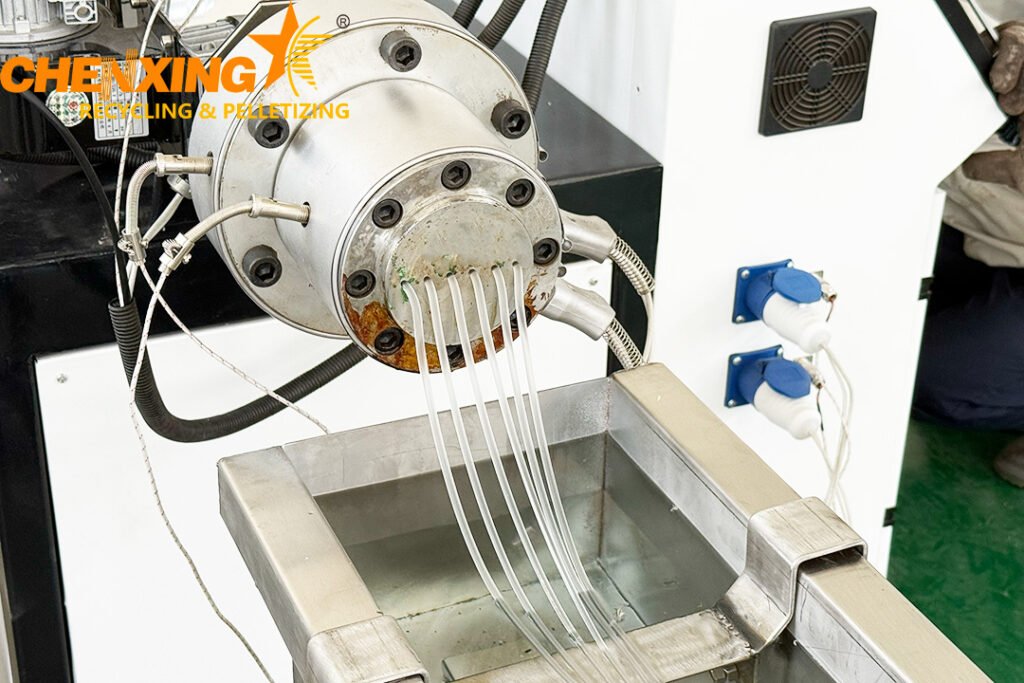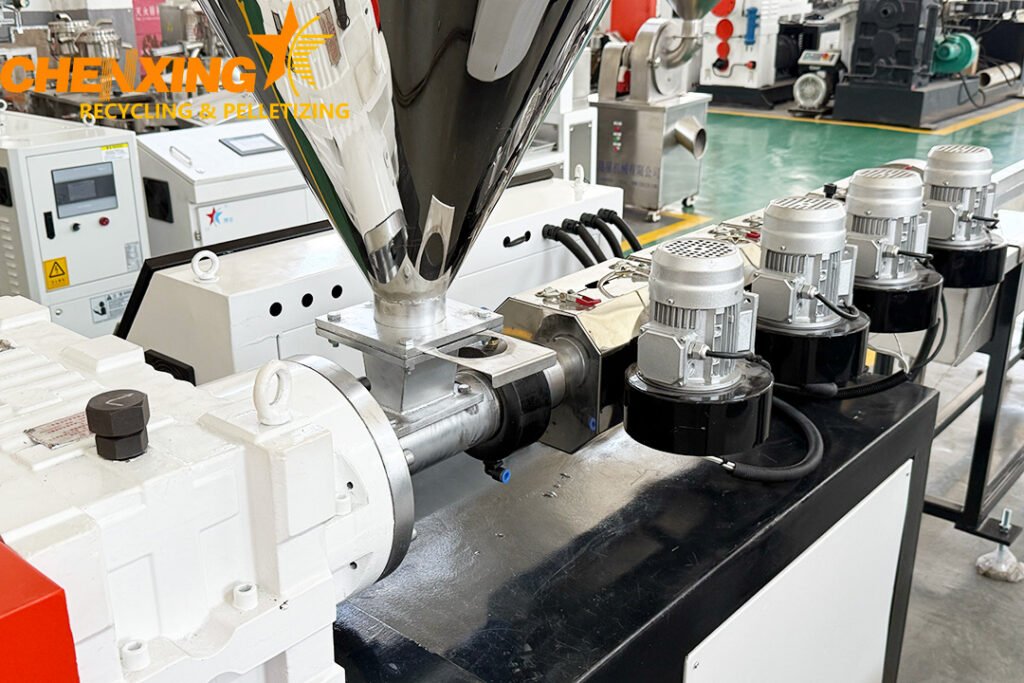Introduction: What Happens After the Plastic Is Cleaned and Melted?
In any recycling plant, there’s a moment when the cleaned, melted plastic has to be transformed into something usable again. And that’s where pelletizing comes in. While there are several ways to turn melted polymers into pellets, one approach—the water strand pelletizing line—has stood the test of time for a reason.
This method, which cools and cuts plastic strands in water, is a favorite in factories where simplicity, reliability, and clarity in operation still matter. If you’re wondering why it’s still so common, or how it works behind the scenes, this guide walks you through it.

What Does a Water Strand Pelletizing Line Actually Do?
In basic terms, this setup pulls strands of molten plastic through a cooling bath, then chops them into small, uniform pellets using a blade-based pelletizer. It’s a bit like making spaghetti and then slicing it into equal pieces—except the material is thermoplastic, and the end goal is reusable granules.
This type of plastic pelletizing machine is especially suited to processors handling:
Polyethylene (PE)
Polypropylene (PP)
Polystyrene (PS)
ABS and blends
Modified biodegradable materials
For mid-capacity facilities and operators dealing with a range of material grades, the line offers a blend of control and efficiency without unnecessary complexity.
What’s Inside a Standard Water Strand Pelletizing System?
Depending on who builds it and how it’s customized, a pelletizing machine plastic system typically includes several interlinked stations:
1. The Extruder
This is where melted plastic starts its journey. The material is heated, mixed, and pressurized in a screw-driven barrel. A consistent melt is crucial—it sets the stage for smooth pellet formation.
2. Die Head
This component shapes the plastic into multiple strands. Uniform melt flow here ensures even strand output, which directly affects pellet quality later on.
3. Water Cooling Channel
Once extruded, the hot strands are pulled through a stainless steel trough filled with water. This rapid cooling stabilizes their shape. Turbulence or poor water circulation can lead to strand bending or breaking—so control matters.
4. Pelletizer
Now cooled, the strands reach a rotating cutter that slices them into pellets. Blade angle, speed, and tension must all be finely tuned.
5. Pellet Dryer
Wet pellets aren’t good for storage or extrusion, so they pass through a drying unit—usually a centrifugal dryer—that spins off moisture efficiently.

How Is Water Strand Different from Other Pelletizing Systems?
There are other ways to pelletize, like underwater and water ring cutting. But strand systems are unique in their visibility—you can see the strands and spot issues early. They’re also more forgiving when it comes to cleaning and changing materials.
| Aspect | Water Strand | Water Ring | Underwater |
|---|---|---|---|
| Cost of Equipment | Moderate | Moderate | High |
| Ease of Maintenance | High | Medium | Lower |
| Ideal For | Versatile Resins | Polyolefins | Engineering Plastics |
| Cleaning/Changeover Time | Quick | Medium | Lengthy |
In short, water strand lines give operators direct control over the process without fully automated complexity.

What Kind of Plastics Work Best in This Line?
This technology can handle a range of materials, including but not limited to:
Injection-grade PP granules
Regrind from PS sheets
Compounded ABS
TPEs with stable viscosity
As long as the plastic doesn’t have extremely low melt strength or high stickiness, chances are a well-tuned water strand system can handle it.
What Are the Practical Benefits of Using a Water Strand Pelletizing Line?
Operators who work with these systems often mention a few advantages:
🔁 Consistency – When the setup is dialed in, pellet size and shape stay uniform
🔧 Ease of inspection – You can visually monitor every stage and correct issues fast
🛠️ Lower service demands – The system is mostly mechanical, with fewer delicate components
🔄 Faster material switchovers – Especially useful for plants running multiple plastic grades
💼 Adaptability – It can serve both recycling and compounding operations
Many small and mid-size processors see it as a reliable all-rounder—simple but effective.
Choosing the Right System: What Should You Focus On?
Know Your Material
High-MFI (Melt Flow Index) plastics may behave differently than tougher resins. Your pelletizer’s cutting mechanics need to match your melt profile.
Think About Your Output
Don’t over-invest in capacity you won’t use. At the same time, a machine running at 90% capacity all day long may wear out faster.
Blade and Die Design
Not all dies are equal. Their size, shape, and finish will affect flow rate and strand quality. Similarly, your blade material determines how long the cutter holds up under load.
Maintenance Access
If changing a blade takes an hour every shift, that’s time lost. Choose a system with operator-friendly access.
Keeping It Running Smooth: Routine Maintenance Tips
To keep a plastic pelletizer performing smoothly:
💡 Monitor blade sharpness every shift
💧 Keep the water tank clean and free of floating particles
🛠️ Lubricate all moving parts regularly
🔎 Clean the die plate before material switches
🌡️ Watch extrusion and cutter temperatures to prevent melt issues
Small steps go a long way in reducing wear and preventing unplanned stops.
Conclusion: Is Water Strand Pelletizing Right for Your Operation?
If you’re recycling or compounding thermoplastics and want a machine that’s reliable, intuitive to run, and cost-effective, the water strand pelletizing line is worth a serious look. It combines hands-on control with solid performance—and doesn’t require a PhD in automation to operate.
From PE film to ABS blends, it handles a variety of jobs with minimal fuss. And when maintained well, it keeps running day after day with low intervention.
📣 Call to Action
Looking for a dependable, well-built water strand pelletizing machine for your production line?
🔍 Visit www.cxrecycling.com to explore our full range of plastic pelletizing equipment, including strand systems built for high uptime and consistent results.
📩 Ready to talk specs or need a quotation? Reach out to our engineering team today.


